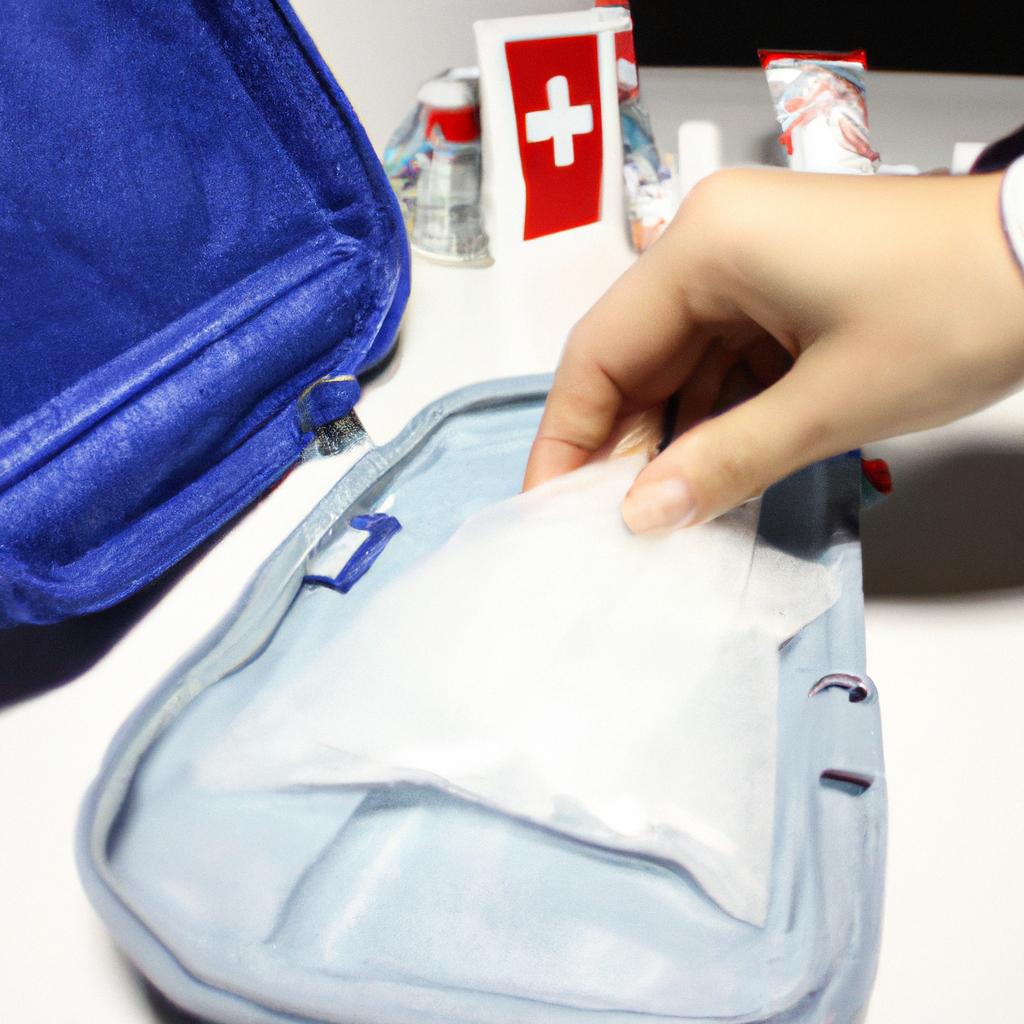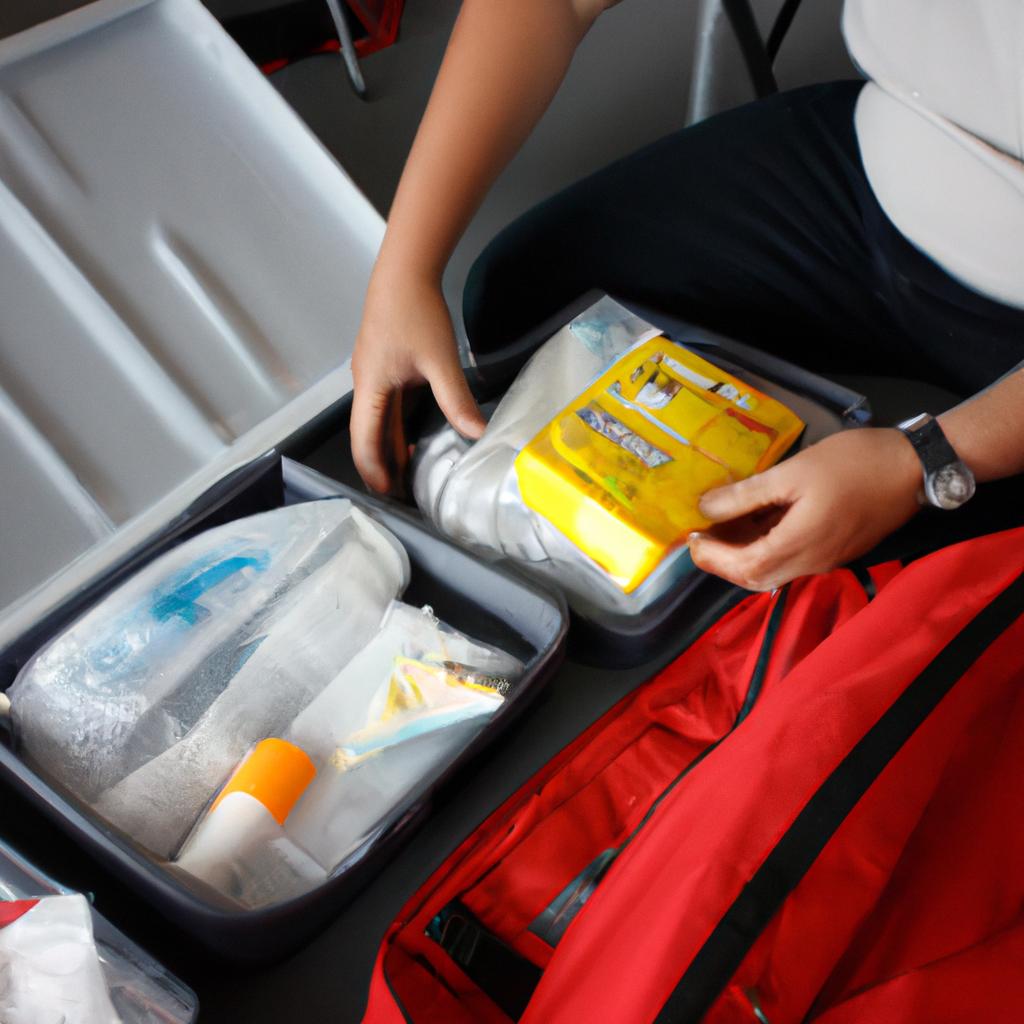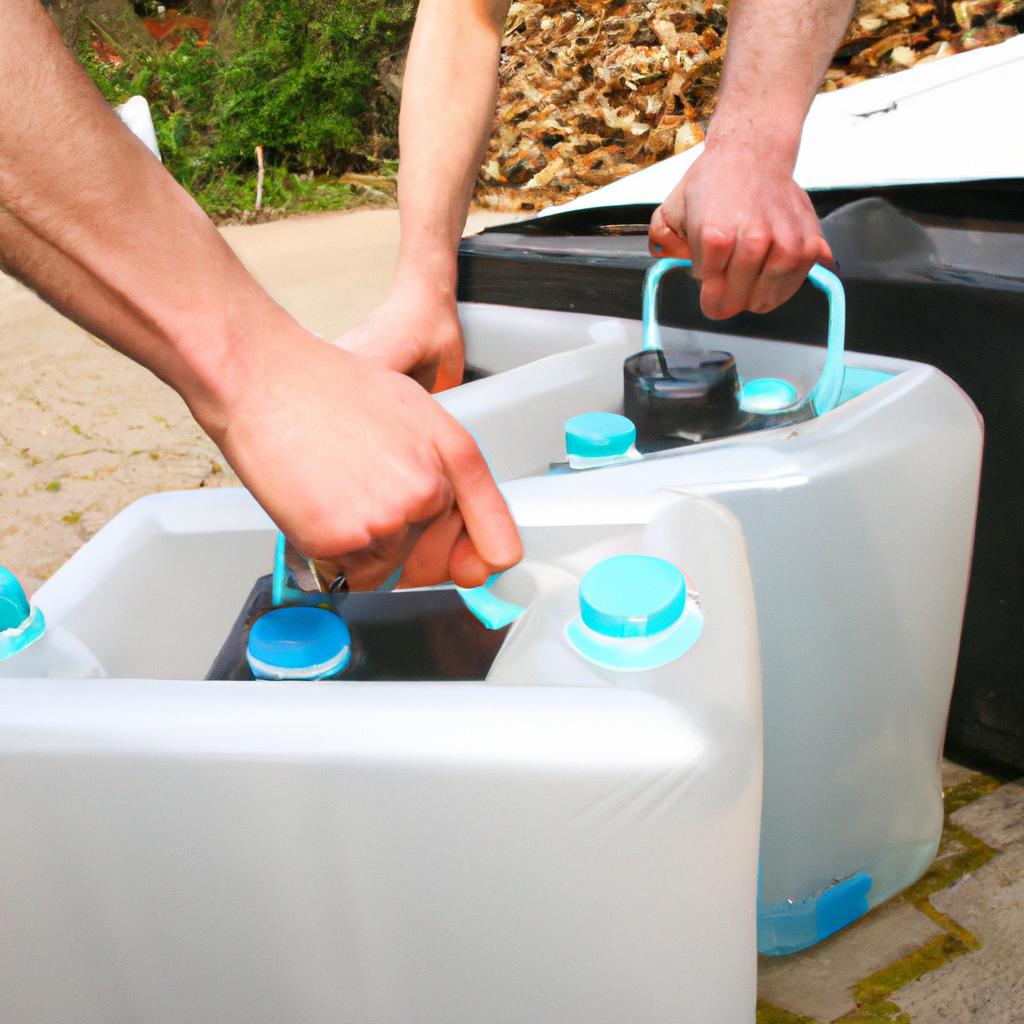In emergency situations, having access to the right first aid supplies can mean the difference between life and death. Whether it is a minor cut or a major trauma, being equipped with essential emergency kits instruments and supplies is crucial for providing immediate care before professional help arrives. For instance, imagine a situation where an individual sustains a deep laceration while hiking in a remote area. In this case, having proper first aid supplies would enable someone to clean the wound, stop bleeding, and potentially prevent infection until they can reach medical assistance.
When it comes to assembling an effective first aid kit, there are several key instruments and supplies that should be included. One of the most important items is adhesive bandages of various sizes, as these are essential for covering small wounds and preventing contamination. Additionally, sterile gauze pads and rolls are necessary for cleaning larger wounds or applying pressure to control bleeding. Another vital component is antiseptic wipes or solutions which help disinfect wounds and reduce the risk of infection. Other essentials include gloves to protect both the caregiver and patient from potential pathogens, tweezers for removing splinters or foreign objects, scissors for cutting tape or clothing if needed, and adhesive tapes for securing dressings or immobilizing joints.
Overall, understanding the Overall, understanding the importance of having a well-stocked and properly organized first aid kit is crucial in emergency situations. By including essential instruments and supplies like adhesive bandages, sterile gauze pads, antiseptic wipes or solutions, gloves, tweezers, scissors, and adhesive tapes, individuals can be prepared to provide immediate care and potentially save lives until professional medical help becomes available. It is also important to regularly check and replenish the supplies in your first aid kit to ensure that everything is up-to-date and ready for use when needed.
Bandages
Imagine a scenario where you are on a hiking trip deep in the wilderness, and suddenly one of your companions falls and sustains a deep cut on their leg. In this critical situation, having an adequate supply of bandages is vital to provide immediate first aid and prevent further injury or infection. Bandages play a crucial role in wound management by providing support, protecting the wound from external contaminants, and promoting healing.
To fully grasp the significance of bandages in emergency situations, it is essential to understand different types and their purposes. There are several varieties available, including adhesive bandages, gauze rolls, triangular bandages, and elastic bandages. Adhesive bandages are often used for minor cuts and abrasions due to their convenience and ease of use. On the other hand, gauze rolls are versatile and can be customized to fit wounds of various sizes. Triangular bandages are commonly employed as slings or immobilizers for fractures or dislocations. Lastly, elastic bandages offer compression that aids in reducing swelling or supporting injured joints.
When considering the importance of bandaging materials during emergencies, we must recognize their potential impact on saving lives. To illustrate this point more vividly:
- A properly applied pressure dressing using a sterile gauze roll stopped severe bleeding after an accident.
- The timely application of an elastic wrap helped stabilize a sprained ankle while awaiting medical assistance.
- A well-fitted sling made from a triangular bandage provided much-needed support for an individual with a broken arm until they could receive proper medical attention.
- An adhesive strip effectively covered a small but deep laceration on someone’s finger while camping far away from any healthcare facility.
By utilizing these examples as case studies alongside real-life experiences shared by countless individuals worldwide, it becomes evident that possessing an ample supply of varied types of bandages can make all the difference when faced with unexpected accidents or injuries.
In the subsequent section, we will explore another important aspect of first aid supplies: antiseptic wipes. These compact and easily transportable items are essential for cleaning wounds to prevent infection and promote healing.
Antiseptic wipes
Bandages are essential first aid supplies that can be used to cover wounds, provide support to injured body parts, and control bleeding. In the previous section, we discussed the different types of bandages available in emergency kits. Now, let’s explore another crucial item found in these kits: antiseptic wipes.
Imagine this scenario: you’re hiking in a remote area when suddenly you trip and scrape your knee on a sharp rock. It starts bleeding profusely, and you need immediate medical attention. This is where antiseptic wipes come into play. These small, individually wrapped wipes contain chemicals that help cleanse the wound and prevent infection.
Antiseptic wipes offer several advantages as part of an emergency kit:
- Portable: They are compact and lightweight, making them easy to carry in your backpack or pocket.
- Convenient: Individually wrapped wipes ensure hygiene and ease of use whenever needed.
- Multipurpose: Antiseptic wipes not only clean wounds but also disinfect surfaces like thermometers or scissors during emergencies.
- Long shelf life: They have a relatively long expiration date, ensuring they remain effective for extended periods.
To further illustrate their importance, consider the following table showcasing common injuries and their corresponding uses for antiseptic wipes:
| Injury | Use of Antiseptic Wipes |
|---|---|
| Cuts | Cleansing the wound before applying a bandage |
| Scrapes | Removing dirt particles from the affected area |
| Burns | Preventing infection while providing relief |
| Bites/Stings | Disinfecting the site after removing stingers |
In summary, antiseptic wipes play a vital role in maintaining cleanliness and preventing infection during emergencies. Their portability, convenience, versatility, and long shelf life make them indispensable components of any well-stocked first aid kit.
Transitioning seamlessly into our next topic about adhesive tape
Adhesive tape
Antiseptic wipes are an important component of any first aid kit as they help prevent infection in minor wounds. However, adhesive tape is another essential item that should not be overlooked. Adhesive tape is versatile and can be used for various purposes such as securing dressings or splints. In this section, we will explore the importance of adhesive tape and its role in providing effective first aid care.
Imagine a scenario where someone sustains a deep cut on their hand while cooking. To ensure proper wound care, it is crucial to clean the wound thoroughly with antiseptic wipes before applying any dressings. Once cleaned, the next step is to secure the dressing in place using adhesive tape. This prevents contamination and promotes faster healing by keeping the wound protected from further damage or exposure to bacteria.
To highlight the significance of adhesive tape in emergency situations, consider these three key points:
- Versatility: Adhesive tape can be easily torn into different lengths and shapes to suit various needs during emergencies.
- Strength: High-quality adhesive tapes have excellent adhesion properties, ensuring that dressings remain securely in place even under challenging circumstances.
- Comfort: The gentle yet firm nature of adhesive tapes allows for comfortable application and removal without causing excessive pain or discomfort.
Let’s now take a closer look at how adhesive tape compares to other commonly used materials when it comes to wound care:
| Material | Pros | Cons |
|---|---|---|
| Adhesive Tape | Provides strong adhesion; versatile | May cause skin irritation |
| Bandages | Easy to use; readily available | Limited flexibility for certain injuries |
| Gauze Pads | Absorbent; suitable for larger wounds | Requires additional material for fixation |
As you can see from the table above, adhesive tape offers unique advantages over other materials commonly used for wound care. Its versatility makes it indispensable in emergency situations where different types of injuries may occur. Although adhesive tape may cause skin irritation in some cases, its benefits outweigh this minor drawback.
Moving forward, let’s explore the next essential item that should be included in every first aid kit: gloves. By having gloves readily available, you can ensure both your safety and the well-being of those receiving first aid assistance.
Gloves
Section H2: Gloves
Transitioning from the previous section on adhesive tape, it is essential to discuss another crucial item in a first aid kit – gloves. Gloves serve as an important protective barrier between the first aider and the patient, minimizing the risk of cross-contamination and potential infections during emergency situations.
Imagine this scenario: you come across a motor vehicle accident where a victim has sustained significant bleeding wounds. The importance of wearing gloves becomes evident when you consider that exposure to bodily fluids could potentially transmit infectious diseases. By donning a pair of gloves before providing assistance, you not only protect yourself but also ensure the safety and well-being of those receiving care.
When assembling your first aid kit, including several pairs of disposable gloves is highly recommended. Here are some reasons why gloves should be an integral part of every emergency kit:
- Protection against bloodborne pathogens: In situations involving open wounds or contact with bodily fluids, wearing gloves acts as a vital safeguard against potentially harmful pathogens.
- Minimizes contamination risks: Gloves create a physical barrier that prevents any microorganisms present on the rescuer’s hands from coming into direct contact with the injured individual.
- Reduces allergic reactions: Some individuals may have latex allergies; therefore, using non-latex gloves can help prevent adverse reactions while still ensuring proper protection.
- Maintains personal hygiene standards: Wearing gloves promotes good hand hygiene practices by acting as a reminder for first aiders to wash their hands thoroughly after removing them.
To highlight the significance of having gloves readily available in emergency scenarios, here is an example bullet point list showcasing real-life benefits:
- Prevents transmission of infectious diseases
- Protects both rescuers and patients from contamination
- Ensures compliance with health and safety regulations
- Promotes hygienic practices within first aid procedures
Additionally, below is a table summarizing different types of gloves commonly used in first aid kits along with their respective advantages and disadvantages:
| Type of Gloves | Advantages | Disadvantages |
|---|---|---|
| Latex | Excellent barrier properties | Potential for allergic reactions |
| Nitrile | Strong and puncture-resistant | Less elasticity compared to latex |
| Vinyl | Cost-effective option | Lower durability than latex or nitrile |
| Neoprene | Resistant to chemicals | May not fit as snugly as other types |
As we move forward, the next section will discuss another crucial item in a well-prepared first aid kit – scissors. These versatile tools play an essential role in emergency situations by enabling quick access to clothing or bandages when time is of the essence.
Transitioning into the subsequent section about “Scissors,” let’s delve into their significance within a comprehensive first aid kit.
Scissors
Moving on from the importance of gloves in first aid procedures, another essential tool to have in your emergency kit is a pair of scissors. These versatile instruments serve various purposes and can be indispensable during critical situations.
Scissors are particularly useful for cutting through clothing or bandages when quick access to an injury is necessary. For instance, imagine a scenario where someone has sustained a deep cut while hiking. In such cases, using scissors allows you to carefully remove their clothing without causing additional harm or aggravating the wound further. By having this instrument readily available in your first aid kit, you can effectively address emergencies that require immediate attention.
When choosing scissors for your emergency kit, consider these factors:
- Quality and durability: Opt for sturdy stainless steel blades that ensure long-term use.
- Size and ease of handling: Select scissors with comfortable grips that provide adequate control during high-pressure situations.
- Rounded tips: This feature minimizes the risk of accidental puncture wounds when working near delicate areas such as the face or neck.
- Compact design: Choose compact scissors that fit easily into your emergency kit without taking up excessive space.
To emphasize the significance of including scissors in your emergency supplies, here’s a real-life example showcasing their crucial role:
Case Study:
During a camping trip, Sarah accidentally sliced her hand while preparing food. Her friend quickly retrieved a pair of sharp medical scissors from their well-stocked first aid kit. The rounded tips ensured safety as they efficiently cut through Sarah’s clothing to expose the wound. This allowed them to promptly apply pressure and dress it appropriately until professional help arrived.
| Scenarios | Importance of Scissors |
|---|---|
| Severed clothing | Quick access to injured areas without causing harm |
| Entangled objects | Safely disentangling items from limbs or body parts |
| Emergency births | Cutting umbilical cords in a controlled and sterile manner |
| Tourniquet | Efficiently cutting fabric for creating a makeshift tourniquet |
Transition into the subsequent section about CPR mask:
In addition to gloves and scissors, another vital tool that should be included in your emergency kit is a CPR mask. This device enables you to provide life-saving assistance during cardiac emergencies without compromising personal safety.
CPR mask
Section Title: Scissors in First Aid Kits
When faced with emergency situations, having the necessary tools readily available is crucial for providing timely and effective first aid. Among these essential instruments, scissors play a vital role in many medical procedures. Whether it’s cutting bandages or clothing to access an injury or removing potentially dangerous objects, scissors are indispensable in any well-equipped first aid kit.
For instance, consider a hypothetical situation where someone sustains a deep laceration on their arm during a hiking trip. In this case, immediate action is required to control bleeding and prevent further damage. With proper training and the use of sterilized scissors from a first aid kit, responders can quickly cut away clothing around the wound area while minimizing contamination risks. This enables them to assess the severity of the injury and apply appropriate measures promptly.
Including sturdy and sharp scissors in your first aid kit ensures you are prepared for various scenarios. Here are some reasons why they should be considered as an essential component:
- Versatility: Scissors serve multiple purposes in first aid applications such as cutting tape, gauze pads, or adhesive strips.
- Efficiency: Having dedicated medical-grade scissors allows responders to efficiently remove clothing obstructing injuries without wasting time searching for alternative tools.
- Safety: The design of medical shears minimizes the risk of accidental injury compared to using regular household scissors.
- Precision: Sharp blades enable precise cutting actions when dealing with delicate materials like dressings or sutures.
To emphasize their importance further, here is a table highlighting different types of scissors commonly found in first aid kits:
| Type | Description |
|---|---|
| Bandage | Designed specifically for cutting through bandages effortlessly. |
| Trauma | Features rounded tips to reduce the likelihood of puncturing the skin accidentally. |
| Utility | Multi-purpose tool suitable for various tasks including cutting clothes or other non-medical items. |
| EMT | Designed specifically for emergency medical technicians, these scissors have additional features such as oxygen tank wrenches and serrated edges. |
In summary, the inclusion of scissors in first aid kits is essential due to their versatility, efficiency, safety, and precision. These instruments enable prompt and effective responses during emergencies where time plays a critical role. By having specialized scissors readily available, responders can swiftly assess injuries and provide appropriate care without compromising patient wellbeing or responder safety.




